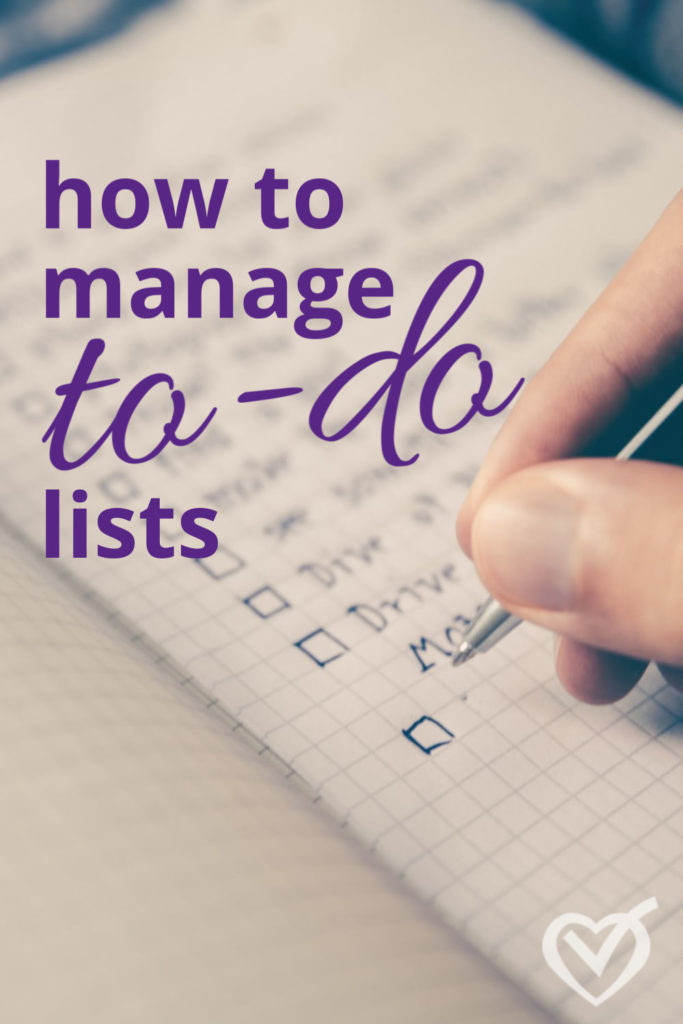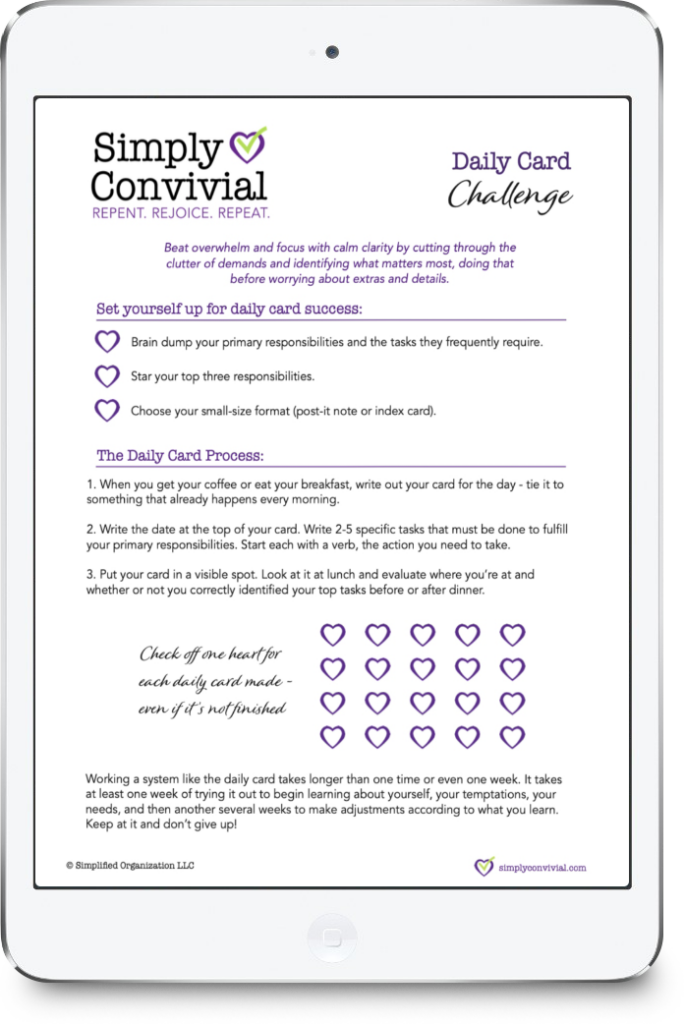
How to manage a to-do list
It’s easy to make a to-do list, but not so easy to follow through with it. Is the problem with our list or with us or with both? We all need to know how to manage a to-do list, because we all have things we need to get done.
To do lists might feel impossible, but with a few simple tactics, we can use to do lists to avoid feeling overwhelmed. Indeed, we might actually come to feel confident instead!
There are three basic steps you need to take to manage your to-do list:
- Make your list reasonable and prioritized.
- Look at your list every day.
- Revise your list once a week.
When we follow these three simple steps, we’ll find that our to-do lists work effectively, keeping us on track to get done our most important work.

PS – at the end of this article, you’ll find a free resource I’ve put together to teach you the habits of effectively managing your to-do list every day.
My YouTube channel has several quick videos with to-do list management tips:
Make your to-do list reasonable and prioritized
When we have lists and lists of undifferentiated, random, mixed up tasks floating around, it takes too much time and mental energy to sort through the clutter and figure out what’s next.
Our to do lists should be set up in such a way that it makes it fast and easy to know what’s next.
First, to keep track of the various projects, responsibilities, and needs in our lives effectively, we need to have multiple to-do lists. Don’t freak out. Each one has a specific job and a different use.
- You need a running to-do list, a catch-all place for the little tasks that pop up. Your mind will relax knowing the random to-do items aren’t lost or forgotten.
- You need a to-do list for each project. Every project has multiple things that need to happen before the project is complete – that’s what makes it a project.
- You need a simple daily to-do list. Make a new, short, prioritized to do list each day, preferably the night before, so you know what’s most important to focus on first.
Second, all your lists need to be reasonable and clear. Are the tasks on that list actually doable? Are they overambitious? If you can break a to-do item down into sub tasks that can be done in under 30 minutes, then you should. What you actually have in that case is not a task, but a project. A project is an outcome you want to achieve that will take multiple steps. Each step is a task, so break it down.
Making your list longer with more to-do items might seem like it will be overwhelming, but what’s actually overwhelming and paralyzing is a list of things that can’t be done or that are ambiguous and vague.
Replace vague phrasing with clarity to help yourself get started with the task. Start each item on your list with a verb, with the action that you need to take.
When our tasks are both written down and phrased well (by starting with the action we need to take), we can use our minds and attention for creative thinking, problem solving, and focused action. To manage a to do list, we need to keep it clear and clarified.
Make a to-do list each day with your top 3 priorities
What we plan to do even a month out can quickly be negated because our lives are not our own orchestration. We’re living lives of service to others, and that means we need to be nimble and adaptable and cheerful in the midst of unexpected change.
If, each day, we choose only 3 Most Important Things (MIT), we get 3 benefits that long to do lists or elaborate planning systems can’t offer:
- Flexibility. Every day, we can take stock of our family’s needs, our energy, our most pressing obligations, and use our to-do list to put first things first. Some days that might mean project tasks, some days it means completing the homeschool day and that’s all, and some days it means dealing with an emergency. Every day, we evaluate and make the best intentional choices we can.
- Manageability. When we’re working to increase our effectiveness, it’s important to see progress rather than failure. Too often, we see all we didn’t do in a day and focus on that, bringing our attitude and energy down. When we complete “everything” on our list, we must also see that we did what needed to be done and must also call it a good day – sometimes we do need that reminder.
- Realism. The limit of 3 reminds us of our finitude. We cannot do all we want to do. We need a to-do list, not a want-to-do list. Choosing 3 tasks forces us to prioritize and focus on what needs to be done rather than what we wish we could do.
So, what sorts of things make it on to this top 3 list?

Get the important things done each day.
Take the daily card challenge and become more effective in your home.
Manage only 3 to do tasks?!
Aren’t there so many more things than 3 to do each day? Yes. There are.
That’s why I get questions like this, often:
Mystie, I really struggle with 3 MITs. Read my Bible, homeschool, and tidy up are always the recurring three. Embarrassing but true, after 9 years of homeschooling, each still has to be written down daily so I make sure it gets done each day. Should I bump up to 6 MIT, to make room for 3 important tasks, or just have 2 separate MIT lists?
One mistake that’s easy to make is to list a project goal instead of a task. A task should take around 15 minutes or less to complete. If it would take longer, it likely could be – and should be – broken up into more manageable chunks.
Yes, that means less progress overall, but it also means you might actually check items off your list instead of avoiding them altogether because each one is too daunting.
If you’re in a survival season, your MITs will be the basics that should be in a routine. If you don’t have a routine plan, you need to create one and practice it as a project first – not add further extras to your plate. There will be other seasons in life, but it’s healthy to recognize when you’re in a season that doesn’t allow you much extra bandwidth.
Whatever your season or your responsibilities, however, the most important mistake to avoid is that of biting off more than you can chew. Make those top 3 tasks actually doable in a day. The point of limiting ourselves to 3 is so that we have a chance of actually crossing things off our list and even completing the list. Don’t defeat that purpose by adding something like
- paint the living room
- reorganize the garage
- go shoe shopping with the kids
That might be a list of three, but each item is huge!
A good rule of thumb is to keep each line item at a 15 minute time estimate.
There are 3 ways you could keep your Daily Top 3 to do list:
- The first option for using an MIT list is the straight-up version. Look over your to-do lists, choose 3, write them down, do them as early in the day as your schedule (or time budget) allows.
- The second option is to choose 3 MITs for different chunks of your day. Divide the day into no more than 3 chunks – for example: morning, afternoon, evening – and choose 3 things to prioritize in each chunk. When your time block begins, do your top three things first before filling in with the lesser, mundane tasks.
- The third option is to choose 3 MITs for up to 3 different roles each day – for example: homeschool teacher, gardener, and homemaker – then decide on the priorities for each area of responsibility each day.
If you use a method that allows you to choose more than 3 tasks, however, you must be careful that those tasks are very bite-sized. Ideally, being able to cross each item off your list should take you no more than 15 minutes.
Sidebar: Survival Mode To-Do List Management
If you’re in survival mode right now, try keeping a daily index card, but without any top MITs. In fact, use half the card or the back half to copy out a mindset-orienting quote or encouraging Bible verse to help you keep your heart centered in the midst of the crazy chaos. Then, write what you did do on your card as you go through the day instead of starting off with a card of what you hope you might do. Give yourself the credit for meeting emergency needs, snuggling babies and toddlers, and feeding and clothing everyone.
Those are three Most Important Things. Count them.
Look at your to-do list every day.
Once we have our lists and they’re orderly, clear, and action-focused, we have to actually look at them – every single day.
Usually, our biggest struggle in managing a to-do list is not the design or the order or the format, but in the looking and using of the lists we have already.
We need to build the habit of looking at our list every day:
- First thing in the morning to clarify our priorities for the day and direct our attention to what matters most.
- When we start to feel scattered and distracted, a glance at our to do list should bring us back to what’s best next to do.
- At a mid-day breaking point like lunch, we should update our list based on what we’ve done and what has emerged in our day.
- At the end of the day we should see how we did, check off what we can, and write a short, priority-focused to do list for the next day.
When we make it routine to look at our list, then it becomes possible and even likely that our next actions will be taken as a direct result of how that list informs our choices.
Revise your to-do list every week.
Life changes. It just does. That means that our lists need to change, too, in response to reality and our actual responsibilities rather than our wishful thinking. We don’t want to waste time with escapist planning, we want to have useful to do lists that actually reflect what we ought to be doing.
A weekly review is a keystone planning practice that we all need to implement if our plans are going to reflect reality and be useful in our day-to-day lives.
During a weekly review, we adjust the to do lists, add to them, delete wishful thinking from them, and choose what’s up next.
Our days should be primarily action-based, working from the lists. But weekly we need to step back and think big picture about what does belong on the list, and make sure they are up to date.
When we have times of work and times of reflective updating and planning, we can keep calm clarity amidst changing needs and circumstances.
Learn more about how to manage a to-do list:

Get the important things done each day.
Take the daily card challenge and become more effective in your home.

